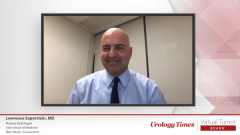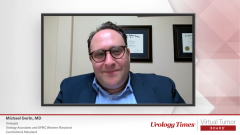
The Multidisciplinary Approach to Prostate Cancer Management
An explanation of the importance of clinical providers following a multidisciplinary approach for prostate cancer management.
Episodes in this series

Neal Shore, MD, FACS: Going back to this, I’d like you all to weigh in on it. Maybe we’ll start with Larry because you touched on it, some of the issues around whether it’s coming from a cyclotron or a generator, half-life—supply chain, logistics issues, which is a new buzzword right now. Supply chain, logistics issues for virtually everything in this world with COVID-19, but that’s going to be important in terms of ordering tests. Of course, having the right type of quality PET [positron emission tomography] camera. Can you comment on that and the ordering process? Then I’d love for both you and Steven to weigh in on the importance of the multidisciplinary approach. I know Michael and I as urologic oncologists, we appreciate how important that is, but maybe for our colleagues in urology and medical oncology, this has opened up a new era for nuclear medicine radiology. Clearly, radiation oncology has been front and center in terms of the advances in radiation, but how we’re going to interdigitate the theragnostics. We’re going to talk more about theragnostics and what that means, and the VISION trial and other things, but I’d love to get some of your thoughts first, Larry, and then maybe Steven, and then Michael.
Lawrence Saperstein, MD: Thanks. That’s a good point, and we’ve always been multidisciplinary, but this has brought it to the forefront for us as nuclear radiologists. We feel privileged to be at the table to have these discussions and to be involved with these decisions. Certainly, we have multidisciplinary tumor boards, urology, radiation-oncology, and us, nuclear medicine, or radiology. That’s exciting, and as you said, I don’t want to get too far ahead of myself with theragnostics, but it’s a new world for nuclear medicine, where we’ll be actively treating these patients where we never did before. And hopefully, we’ll be involved with the decisions and the care of these patients on some level. Again, it seems a win-win for us and the patients, so we’re excited to be here.
Neal Shore, MD, FACS: That’s great. Steven?
Steven Finkelstein, MD, DABR, FACRO: As we look at a multidisciplinary approach, speaking as a radiation oncologist, we embraced FDG [fluorodeoxyglucose]-PET very early in the process in tumors such as lung cancer and GYN [gynecologic] cancer. And we were dying to have the right imaging in prostate cancer. The problem is we never really did, and some of the early imaging that was alluded to earlier in this talk showed the fact that we could target lesions, whether it be in the primary setting, in the recurrent setting, or even the oligometastatic setting. We’re all desiring the ability to have really high-quality next-generation imaging that is available not just at academic centers, but in the community setting. When we talk about access to PSMA [prostate-specific membrane antigen] PET, right now, it’s more limited than we would like in the community setting. If you ask the why of that, there are some people who just have not quite embraced the fact that these are not just available, but they’re also reimbursable. And as it goes through this process, we’re going to see in the next year that the availability of this increases dramatically.
In a multidisciplinary way, the best quality care is given when you have urologic oncologists working with radiation oncologists, working with nuclear medicine physicians. That team approach gives the ability to have anatomy as destiny, where you can find the problem on a picture, use techniques, whether it be what I do as a radiation oncologist to treat it with radiation, or if it’s surgery, to be able to do it with surgical techniques. But if anatomy is destiny, you need specific technologies to be able to identify where the lesions are.
Transcript edited for clarity.
Newsletter
Stay current with the latest urology news and practice-changing insights — sign up now for the essential updates every urologist needs.























